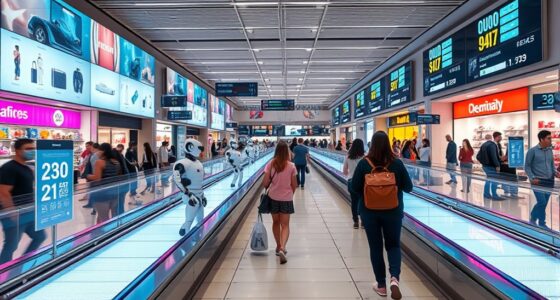Generative AI is revolutionizing retail by acting as the new store architect, creating personalized shopping experiences and streamlining operations at a remarkable scale. With widespread adoption, AI enhances customer engagement, optimizes supply chains, and enables smarter marketing strategies. Its rapid growth is shaping a future where digital commerce feels seamless and tailored. If you want to see how this transformation unfolds and impacts your business, keep exploring the possibilities ahead.
Key Takeaways
- Generative AI is transforming retail by enabling personalized shopping experiences and data-driven decision-making.
- AI-driven tools like chatbots and targeted recommendations enhance customer engagement and loyalty.
- Retailers are increasing AI investments, aiming to optimize supply chains and increase operational efficiency.
- The market for AI in retail is projected to surpass $356 billion by 2030, fueling industry growth.
- AI is redefining commerce operations, making it the new “store architect” for seamless, personalized digital experiences.

As generative AI rapidly transforms the business landscape, more companies are embracing its capabilities to enhance commerce operations. You’re likely to notice how AI is reshaping everything from customer service to supply chain management, making processes faster, smarter, and more personalized. The rapid adoption rates speak for themselves: enterprise use of generative AI jumped from 33% in 2023 to 71% by mid-2024, with 89% planning to advance their AI initiatives by 2025. Major brands like Amazon, Walmart, and Coca-Cola already leverage AI extensively, and Bain & Company reports that 95% of U.S. companies use generative AI tools such as language models and image generation by 2025. Globally, 89% of businesses are either testing or actively using AI, highlighting its widespread acceptance in commerce. Enterprise investment in GAI continues to accelerate, with 92% of Fortune 500 companies adopting these technologies. You can expect to see AI spending increase sharply, especially in retail, where NVIDIA notes that 97% of retailers plan to expand their AI budgets in the coming fiscal year. This investment fuels a market projected to grow at a CAGR of 46.47%, reaching over $356 billion by 2030 worldwide. Bloomberg forecasts the global generative AI market could surpass $1.3 trillion by 2032, with the U.S. market alone expected to hit over $302 billion by 2034. The impact on productivity is substantial, potentially adding between $2.6 trillion and $4.4 trillion annually across industries like retail and CPG. In retail and CPG sectors, AI-driven improvements could boost revenues by 1.2 to 2 percent, translating to an extra $400-660 billion in value. AI’s integration into commerce operations is already transforming how you shop online. AI streamlines customer service, personalizes marketing, and optimizes supply chains. Enhanced data analytics enable more accurate demand forecasting and inventory management, further improving efficiency. Ecommerce platforms using generative AI are valued at $8.65 billion in 2025, with AI-driven customer engagement improving by nearly 50%. Personalized experiences powered by AI increase repeat purchases by recognizing buyer intent and tailoring recommendations. As 78% of businesses now use AI in at least one function—up from 55% last year—you’ll encounter smarter chatbots and more targeted sales suggestions. With online shopping expected to account for nearly a quarter of retail sales in 2025, AI is becoming the new architect of commerce, shaping a future where digital experiences are more seamless, personalized, and efficient than ever before.
Frequently Asked Questions
How Will Generative Commerce Impact Traditional Retail Jobs?
Generative commerce will transform your retail job by automating routine tasks like customer support and inventory management, freeing you to focus on more complex, emotionally intelligent roles. You’ll need new skills in data analysis and AI oversight, shifting your responsibilities from manual work to strategy and customer experience design. Embrace reskilling opportunities, as your role evolves towards higher-value functions, making your contribution more impactful in this AI-driven retail landscape.
What Are the Ethical Considerations of Ai-Driven Store Design?
You need to guarantee your AI-driven store design is transparent, explaining decisions clearly to build trust. Prioritize fairness by continuously monitoring for biases, especially against minority groups. Respect customer privacy by obtaining consent and handling data ethically. Establish accountability with governance frameworks and human oversight, ensuring responsible AI use. By doing so, you foster trust, mitigate risks, and create an inclusive shopping environment that aligns with societal values and legal standards.
Can Small Businesses Leverage Generative Commerce Effectively?
Yes, small businesses can leverage generative commerce effectively by embracing AI-powered personalization, streamlining operations, and expanding digital presence. By adopting multiple technology platforms, you can enhance customer engagement and boost sales. Investing in AI education and staying compliant with regulations will help you overcome barriers. Early adoption enables you to stay competitive, improve efficiency, and capitalize on emerging payment options like cryptocurrencies, ultimately driving growth and resilience in your business.
How Does AI Ensure Data Privacy in Personalized Shopping Experiences?
Did you know 81% of consumers say trusting a brand is essential? AI guarantees data privacy in personalized shopping by using techniques like data minimization and anonymization, which limit the exposure of personal info. It also employs encryption, role-based access controls, and real-time monitoring to secure data. Consent management tools keep customers informed and in control, fostering trust while AI balances personalization with rigorous privacy safeguards.
What Are the Limitations of Current AI Technologies in Store Architecture?
You’ll find that current AI technologies face significant limitations in store architecture. They often struggle with incomplete or poor-quality data, leading to inaccurate layout suggestions. Integration with legacy systems can be complex and costly, delaying implementation. Workforce skill gaps and resistance slow adoption, while ethical and privacy concerns require careful management. These factors restrict AI’s ability to deliver fully optimized, real-time store designs, hindering its potential to revolutionize retail spaces.
Conclusion
As you step into this new era, AI becomes the master builder of your shopping universe, shaping spaces that feel uniquely yours—like a lighthouse guiding you through uncharted waters. With each innovation, AI transforms mere transactions into personalized journeys, illuminating your path like a steady flame. Embrace this dawn of generative commerce, where AI isn’t just constructing stores, but forging a future where every experience is a beacon of possibility, shining brightly just for you.









